Numerical Investigation of Internal Flow Properties around Horizontal Layered Trees by Using the Reynolds Stress Model
Abstract
1. Introduction
2. Governing Mathematical Equations of Reynolds-Averaged Navier–Stokes (RANS) Equations for the RSM Model
3. Materials and Methods
3.1. Conditions for Validation of the Numerical Model
3.1.1. Experimental Setup
3.1.2. Numerical Model Setup
3.1.3. Validation of the Numerical Model
3.2. Conditions for the Present Numerical Model
3.2.1. Flow Conditions for the Numerical Model
3.2.2. Model Conditions for Trees
3.2.3. Selected Cases and Measurement Positions
3.2.4. Preprocessing and Post-Processing
4. Results and Discussion
4.1. Vertical Distribution of Velocities
4.1.1. Vertical Distribution of Longitudinal Velocity (u)
4.1.2. Vertical Distribution of Lateral Velocity (v)
4.1.3. Vertical Distribution of Depthwise Velocity (w)
4.2. Vertical Distribution of Reynolds Stresses
4.2.1. Normal Stresses (u’u’)
4.2.2. Normal Stresses (v’v’)
4.2.3. Normal Stresses (w’w’)
4.2.4. Reynolds Shear Stresses (u’w’)
4.3. Distribution of Turbulence Kinetic Energy
4.4. Turbulence Eddy Dissipation Rate
5. Conclusions
- In all cases, the mean streamwise (u’), lateral (v’), and vertical (w’) velocity profiles consisted of a sharp inflection point in the zone 0.035 m < z < 0.04 m at all those locations lying inside, upstream, and downstream of the short trees (). This was due to the maximum generation of vortices that gave rise to the momentum transfer between the overlying flow and the tops of the shorter trees, which indicatively represent a gradient of velocity in this zone. There was an approximate 31–65% increase in the streamwise velocities at locations 1-6 in cases 1–2 and a 54–77% increase at locations 7–10 in cases 3–4 in the unvegetated zone (z > 0.035 m) compared to the vegetated zone (z < 0.035 m) below the short trees. In contrast, the trend of streamwise velocities amongst the taller trees was almost constant from bed to top due to continuous resistance up to tops of the tall trees.
- In all cases, the normal stresses were higher at those locations lying amongst the taller trees and almost constant from bed to top as compared to the locations of submerged trees, where sharp inflection points were observed at the interface of the submerged trees due momentum exchange between the flow layers. Meanwhile, the normal stresses were lesser directly downstream of the cylinders at locations 3-7 as compared to locations 4 and 8.
- The magnitude of the turbulence kinetic energy was significantly larger inside the short and tall tree cylinders as compared to the unvegetated regions, i.e., the upstream and downstream regions. Similarly, the production of turbulence kinetic energy was approximately 50% and 70% greater inside the tree region (Z < 0.035) as compared to above the shorter trees during cases 1–2 and cases 3–4, respectively.
- The sawtooth pattern in the turbulence eddy dissipation rate was noticed in all cases inside the tree region, while a greater eddy dissipation rate was observed amongst the tall trees as compared to the short trees. This was due to the significantly higher continuous flow resistance offered by the tall trees up to the tops of the taller tree cylinders.
Author Contributions
Funding
Acknowledgments
Conflicts of Interest
References
- Mori, N.; Takahashi, T. The 2011 Tohoku Earthquake Tsunami Joint Survey Group, 2012. Nationwide post event survey and analysis of the 2011 Tohoku earthquake tsunami. Coast Eng. J. 2011, 52, 1250001-1–1250001-27. [Google Scholar]
- Danielsen, F.; Sorensen, M.K.; Olwig, M.F.; Selvam, V.; Parish, F.; Burgess, N.D.; Hiraishi, T.; Karunagaran, V.M.; Rasmussen, M.S.; Hansen, L.B.; et al. The Asian tsunami: A protective role for coastal vegetation. Science 2005, 310, 643. [Google Scholar] [CrossRef]
- Suppasri, A.; Koshimura, S.; Imai, K.; Mas, E.; Gokon, H.; Muhari, A.; Imamura, F. Developing tsunami fragility curves from the surveyed data of the 2011 Great East Japan tsunami in Sendai and Ishinomaki Plains. Coast. Eng. J. 2012, 54, 1250008-1–1250008-16. [Google Scholar] [CrossRef]
- Nateghi, R.; Bricker, J.D.; Guikema, S.D.; Bessho, A. Statistical analysis of the effectiveness of seawalls and coastal forests in mitigating tsunami impacts in Iwate and Miyagi prefectures. PLoS ONE 2016, 11, e0158375. [Google Scholar] [CrossRef] [PubMed]
- Fraser, S.; Raby, A.; Pomonis, A.; Goda, K.; Chian, S.C.; Macabuag, J.; Offord, M.; Saito, K.; Sammonds, P. Tsunami damage to coastal defences and buildings in the March 11th, 2011 Mw 9.0 Great East Japan earthquake and tsunami. Bull. Earthq. Eng. 2013, 11, 205–239. [Google Scholar] [CrossRef]
- Osti, R.; Tanaka, S.; Tokioka, T. The importance of mangrove forest in tsunami disaster mitigation. Disasters 2009, 33, 203–213. [Google Scholar] [CrossRef] [PubMed]
- Kathiresan, K.; Rajendran, N. Coastal mangrove forests mitigated tsunami. Estuar. Coast. Shelf Sci. 2005, 65, 601–606. [Google Scholar] [CrossRef]
- Yanagisawa, H.; Koshimura, S.; Goto, K.; Miyagi, T.; Imamura, F.; Ruangrassamee, A.; Tanavud, C. The reduction effects of mangrove forest on a tsunami based on field surveys at Pakarang Cape, Thailand and numerical analysis. Estuar. Coast. Shelf Sci. 2009, 81, 27–37. [Google Scholar] [CrossRef]
- Yanagisawa, H.; Koshimura, S.; Miyagi, T.; Imamura, F. Tsunami damage reduction performance of a mangrove forest in Banda Aceh, Indonesia inferred from field data and a numerical model. J. Geophys. Res. 2010, 115, C06032. [Google Scholar] [CrossRef]
- Takemura, T.; Tanaka, N. Flow structures and drag characteristics of a colony type emergent roughness model mounted on a flat plate in uniform flow. Fluid Dyn. Res. 2007, 39, 694–710. [Google Scholar] [CrossRef]
- Huai, W.; Wang, W.; Hu, Y.; Zeng, Y.; Keith, Z.Y. Analytical model of the mean velocity distribution in an open channel with double-layered rigid vegetation. Adv. Water Resour. 2014, 69, 106–113. [Google Scholar] [CrossRef]
- Lima, P.; Janzen, J.; Nepf, H. Flow patterns around two neighbouring patches of emergent vegetation and possible implications for deposition and vegetation growth. Environ. Fluid Mech. 2015, 15, 881–898. [Google Scholar] [CrossRef]
- Shimizu, Y.; Tsujimoto, T. Numerical analysis of turbulent open-channel flow over vegetation layer using a k-ɛ turbulence model. J. Hydrosci. Hydraul. Eng. 1994, 11, 57–67. [Google Scholar]
- Singh, P.; Rahimi, H.R.; Tang, X. Parameterization of the modeling variables in velocity analytical solutions of open-channel flows with double-layered vegetation. Environ. Fluid Mech. 2019, 19, 765–784. [Google Scholar] [CrossRef]
- Poggi, D.; Porporato, A.; Ridolfi, L.; Albertson, J.D.; Katul, G.G. The effect of vegetation density on canopy sub-layer turbulence. Bound. Layer Meteorol. 2004, 111, 565–587. [Google Scholar] [CrossRef]
- Raupach, M.R.; Shaw, R.H. Averaging procedures for flow within vegetation canopies. Bound. -Layer Meteorol. 1982, 22, 79–90. [Google Scholar] [CrossRef]
- Anjum, N.; Ghani, U.; Pasha, G.A.; Latif, A.; Sultan, T.; Ali, S. To investigate the flow structure of discontinuous vegetation patches of two vertically different layers in an open channel. Water 2018, 10, 75. [Google Scholar] [CrossRef]
- Pu, J.H.; Hussain, A.; Guo, Y.K.; Vardakastanis, N.; Hanmaiahgari, P.R.; Lam, D. Submerged flexible vegetation impact on open channel flow velocity distribution: An analytical modelling study on drag and friction. Water Sci. Eng. 2019, 12, 121–128. [Google Scholar] [CrossRef]
- Kundu, P.; Kumar, V.; Hoarau, Y. Numerical simulation and analysis of fluid flow hydrodynamics through a structured array of circular cylinders forming porous medium. Appl. Math. Model. 2016, 40, 9848–9871. [Google Scholar] [CrossRef]
- Wang, W.; Huai, W.X.; Gao, M. Computation of flow structure through double layer vegetation. Math. Comput. Methods Sci. Eng. 2014, 132–136. [Google Scholar]
- Ghani, U.; Anjum, N.; Pasha, G.A.; Ahmad, M. Numerical investigation of the flow characteristics through discontinuous and layered vegetation patches of finite width in an open channel. Environ. Fluid Mech 2019, 19, 1469–1495. [Google Scholar] [CrossRef]
- Xiaohui, S.; Li, C.W. Large eddy simulation of free surface turbulent flow in partly vegetated open channels. Int. J. Numer. Methods Fluids 2002, 39, 919–937. [Google Scholar] [CrossRef]
- Yan, C.; Nepf, H.M.; Huang, W.X.; Cui, G.X. Large eddy simulation of flow and scalar transport in a vegetated channel. Environ. Fluid Mech. 2017, 17, 497–519. [Google Scholar] [CrossRef]
- Wu, W.; Shields, F.D., Jr.; Bennett, S.J.; Wang, S.S.Y. A depth averaged two-dimensional model for flow, sediment transport, and bed topography in curved channels with riparian trees. Water Resour. Res. 2005, 41, 1–15. [Google Scholar] [CrossRef]
- Tanaka, N. Numerical Investigation of 3D Flow Properties around Finite Emergent Trees by Using the Two-Phase Volume of Fluid (VOF) Modeling Technique. Fluids 2022, 7, 175. [Google Scholar] [CrossRef]
- Zhao, F.; Huai, W. Hydrodynamics of discontinuous rigid submerged trees patches in open-channel flow. J. Hydro-Environ. Res. 2016, 12, 148–160. [Google Scholar] [CrossRef]
- Harada, K.; Kawata, Y. Study on tsunami reduction effect of coastal forest due to forest growth. Ann. Disaster Prev. Res. Inst. 2005, 48C, 161–165. [Google Scholar]
- Hiraishi, T.; Harada, K. Greenbelt tsunami prevention in South-Pacific region. Rep. Port Airpt. Res. Inst. 2003, 42, 23. [Google Scholar]
- Tanaka, N. Variation of tree crown height effects on flow behavior around finite vegetation. J. Appl. Water Eng. Res. 2022, 1–13. [Google Scholar] [CrossRef]
- Tanaka, N. Experimental Study to Evaluate the Effectiveness of the Variation in Crown Portion of a Tree on the Flow Properties Considering the Finite Length Forest. Int. J. Civ. Eng. 2022, 20, 1461–1478. [Google Scholar] [CrossRef]
- Ishigaki, A.; Higashi, H.; Sakamoto, S.; Shibahara, S. The Great East–Japan earthquake and devastating tsunami: An update and lessons from the past great earthquakes in Japan since 1923. Tohoku J. Exp. Med. 2013, 229, 287–299. [Google Scholar] [CrossRef]
- Samarakoon, M.B.; Tanaka, N.; Iimura, K. Improvement of effectiveness of existing Casuarina equisetifolia forests in mitigating tsunami damage. J. Environ. Manag. 2013, 114, 105–114. [Google Scholar] [CrossRef] [PubMed]
- Liu, D.; Diplas, P.; Hodges, C.C.; Fairbanks, J.D. Hydrodynamics of flow through double layer rigid vegetation. Geomorphology 2010, 116, 286–296. [Google Scholar] [CrossRef]
- Roulund, A.; Sumer, B.M.; Fredsfe, J.; Michelsen, J. Numerical and experimental investigation of flow and scour around a circular pile. J. Fluid Mech. 2005, 534, 351–401. [Google Scholar] [CrossRef]
- Anjum, N.; Tanaka, N. Numerical investigation of velocity distribution of turbulent flow through vertically double-layered vegetation. Water Sci. Eng. 2019, 12, 319–329. [Google Scholar] [CrossRef]
- Choi, S.U.; Kang, H. Reynolds stress modeling of vegetated open-channel flows. J. Hydraul Res. 2004, 42, 3–11. [Google Scholar] [CrossRef]
- Fritz, H.M.; Borrero, J.C.; Synolakis, C.E.; Yoo, J. 2004 Indian Ocean tsunami flow velocity measurements from survivor videos. Geophys. Res. Lett. 2006, L33, 24605. [Google Scholar] [CrossRef]
- Tanaka, N.; Sasaki, Y.; Mowjood, M.I.M.; Jinadasa, K.B.S.N.; Homchuen, S. Coastal trees structures and their functions in tsunami protection: Experience of the recent Indian Ocean tsunami. Lands. Ecol. Eng. 2007, 3, 33–45. [Google Scholar] [CrossRef]
- Jayatissa, L.P.; Dahdouh Guebas, F.; Koedam, N. A review of the floral composition and distribution of mangroves in Sri Lanka. Bot. J. Linn. Soc. 2002, 138, 29–43. [Google Scholar] [CrossRef]
- Wolanski, E.; Jones, M.; Bunt, S.J. Hydrodynamics of a tidal creek-mangrove swamp system. Aust. J. Mar. Freshw. Res. 1980, 31, 431–450. [Google Scholar] [CrossRef]
- Zheng, J.H.; Wang, J.C.; Zhou, C.Y.; Zhao, H.J.; Sang, S. Numerical simulation of typhoon-induced storm surge along Jiangsu coast, Part II: Calculation of storm surge. Water Sci. Eng. 2017, 10, 8–16. [Google Scholar] [CrossRef]
- Fluent Inc User’s Guide; Release 19.2; ANSYS, Inc.: Canonsburg, PA, USA, 2020.
- Rahimi, H.R.; Tang, X.; Singh, P. Experimental and numerical study on impact of double layer vegetation in open channel flows. J. Hydrol. Eng. 2020, 25, 04019064. [Google Scholar] [CrossRef]
- Righetti, M.; Armanini, A. Flow resistance in open channel flows with sparsely distributed bushes. J. Hydrol. 2002, 269, 55–64. [Google Scholar] [CrossRef]
- Liu, D.; Diplas, P.; Fairbanks, J.D.; Hodges, C.C. An experimental study of flow through rigid vegetation. J. Geophys. Res. 2008, 113, 1–16. [Google Scholar] [CrossRef]
- Yan, X.; Wai, W.O.; Li, C. Characteristics of flow structure of free-surface flow in a partly obstructed open channel with vegetation patch. Environ. Fluid Mech. 2016, 16, 807–832. [Google Scholar] [CrossRef]

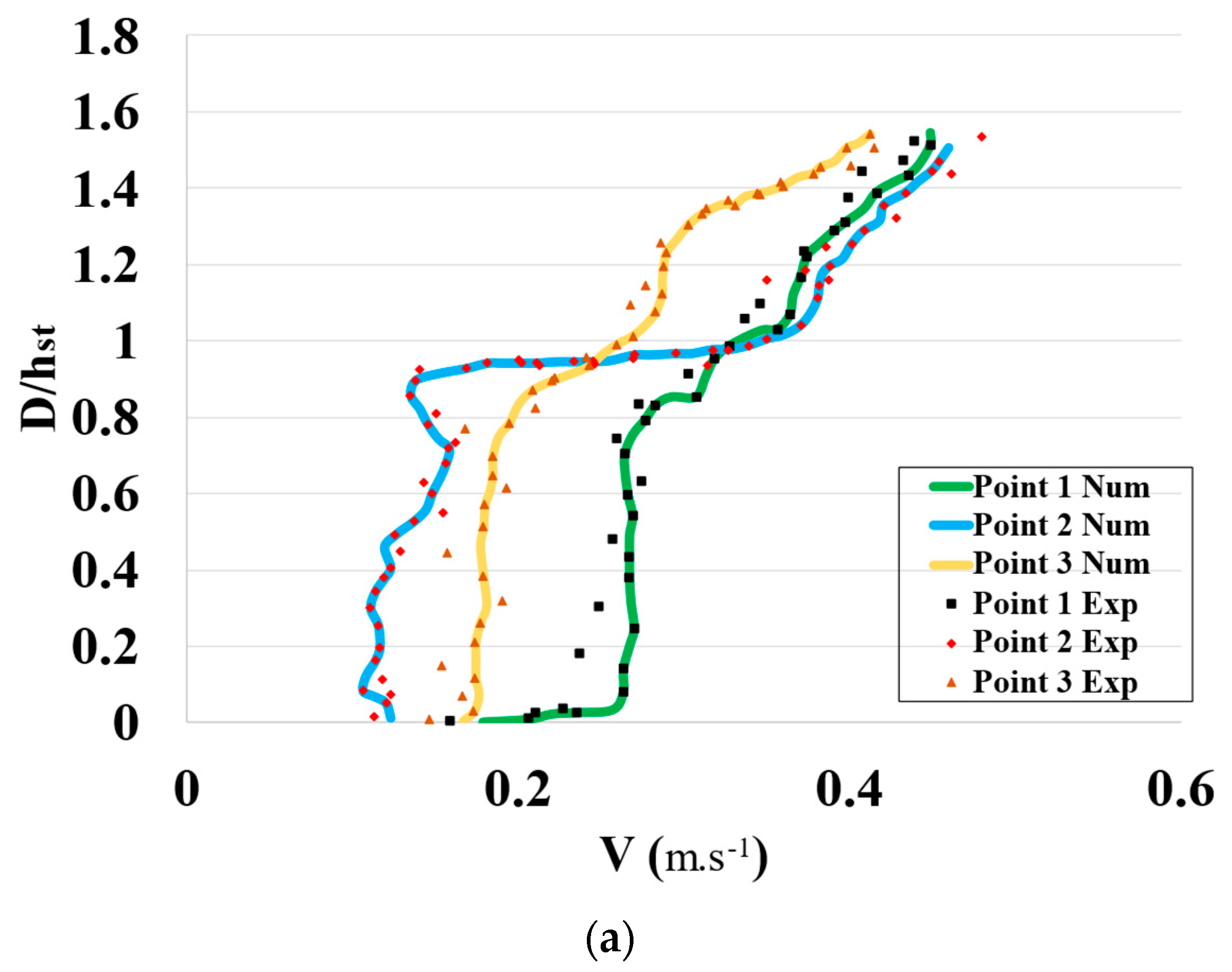
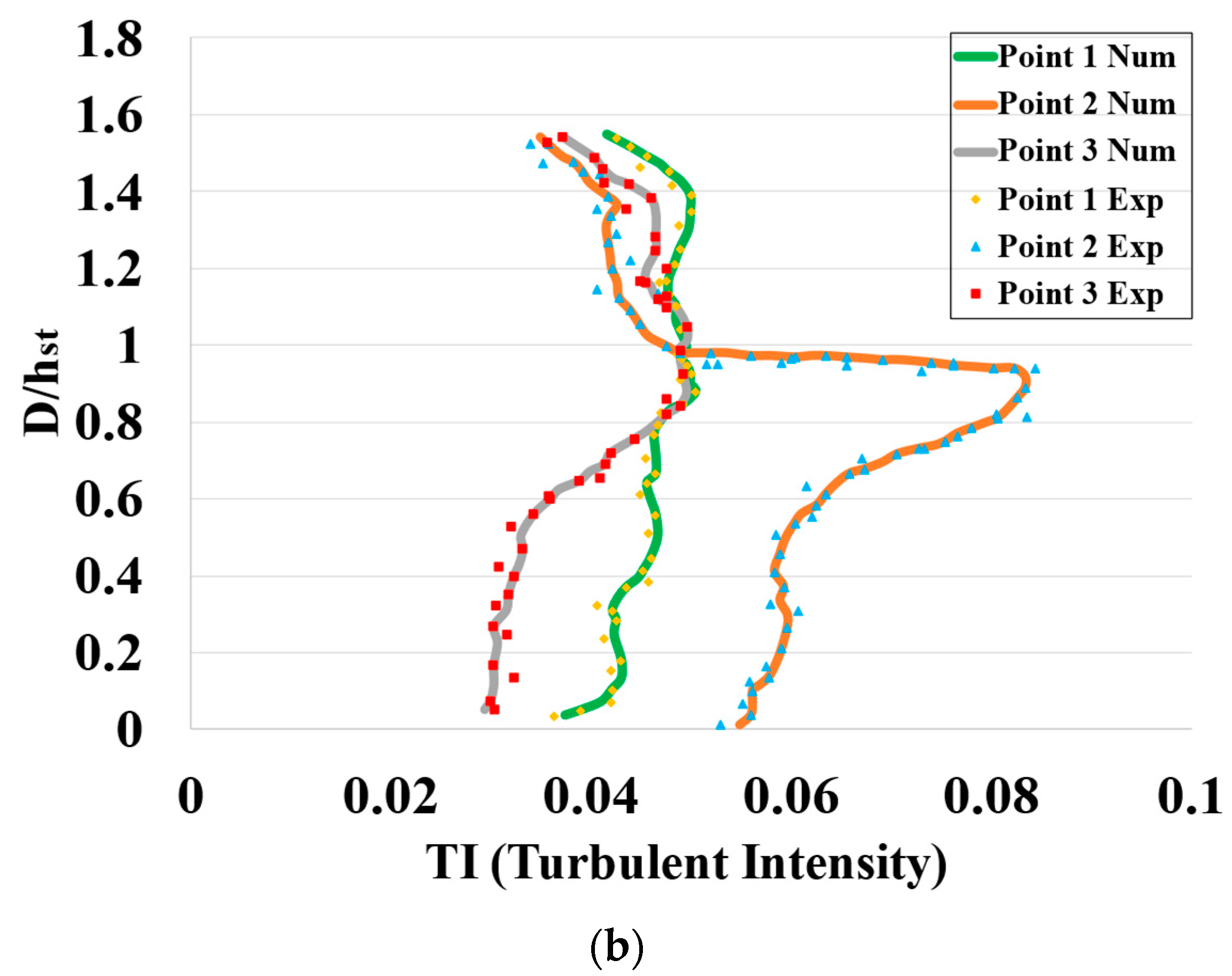


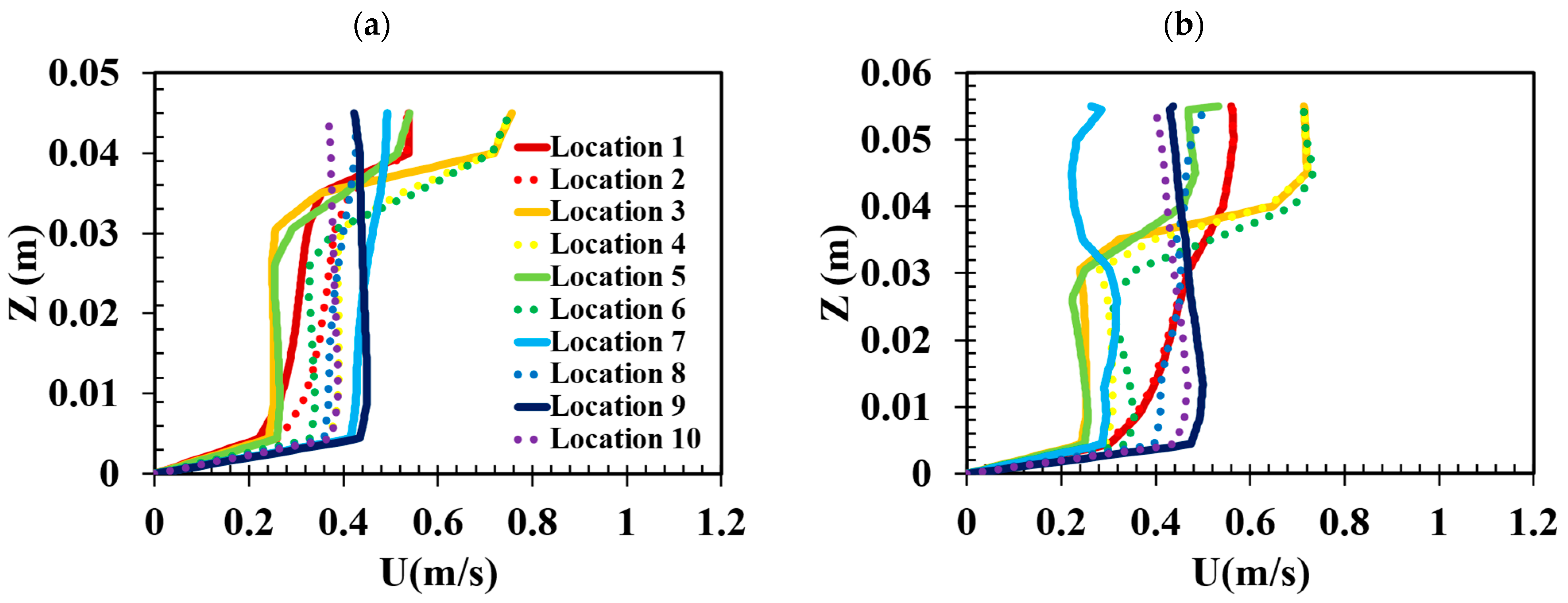
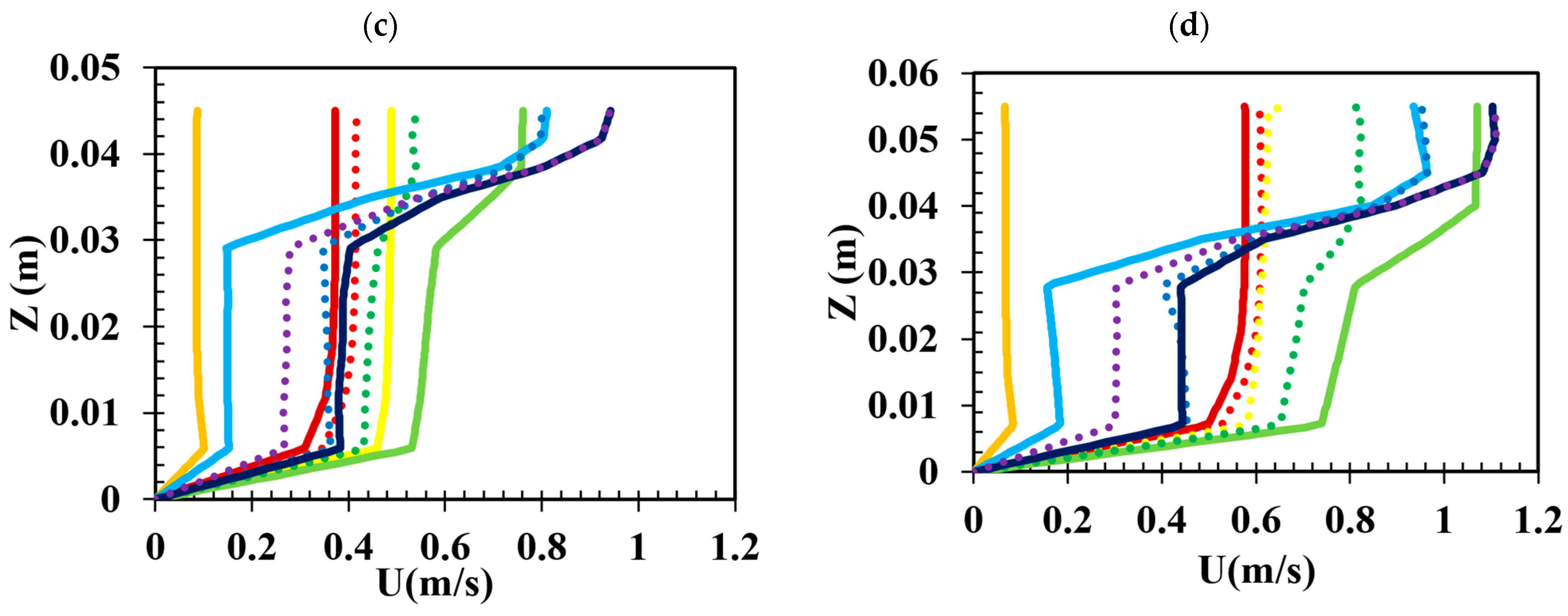
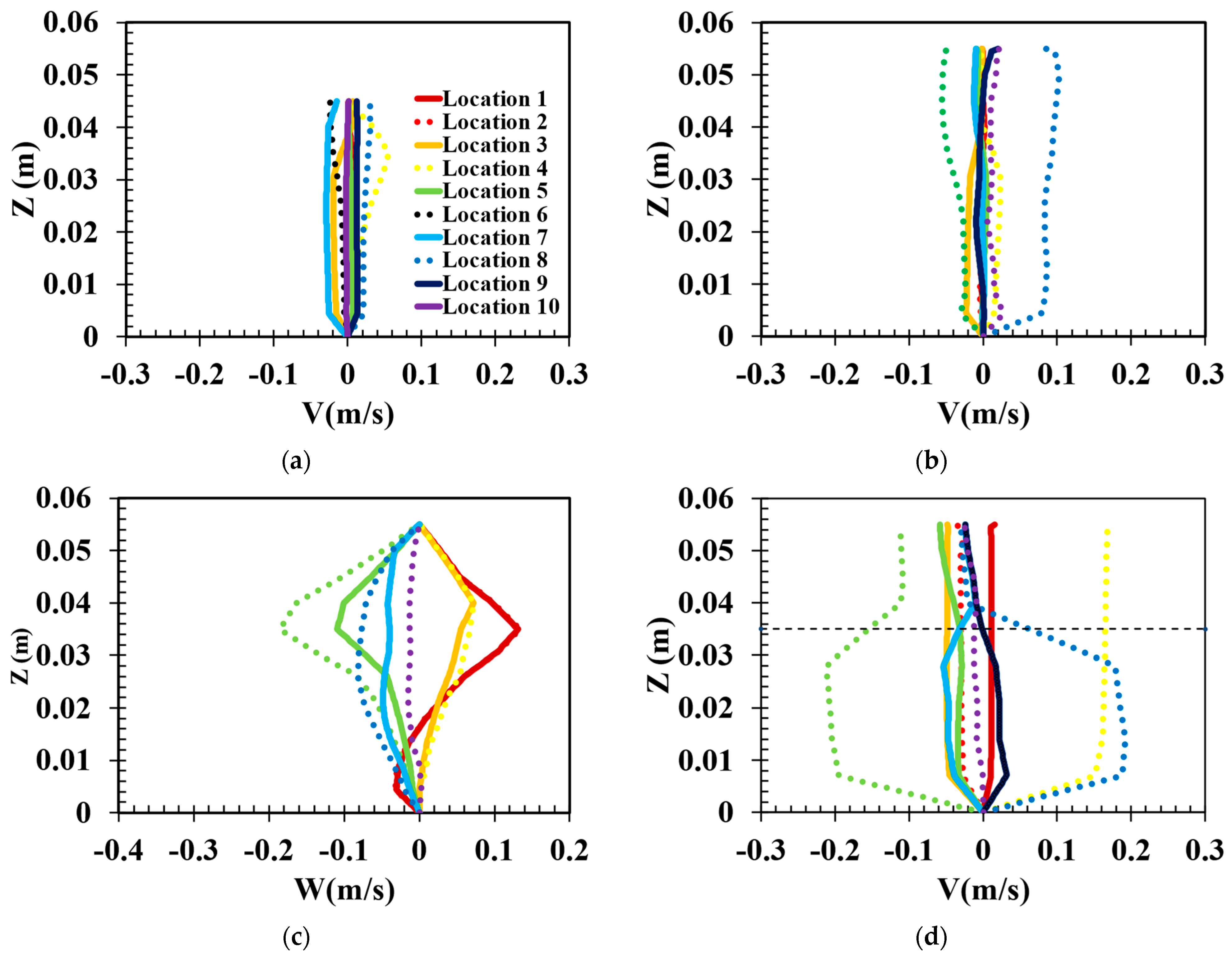
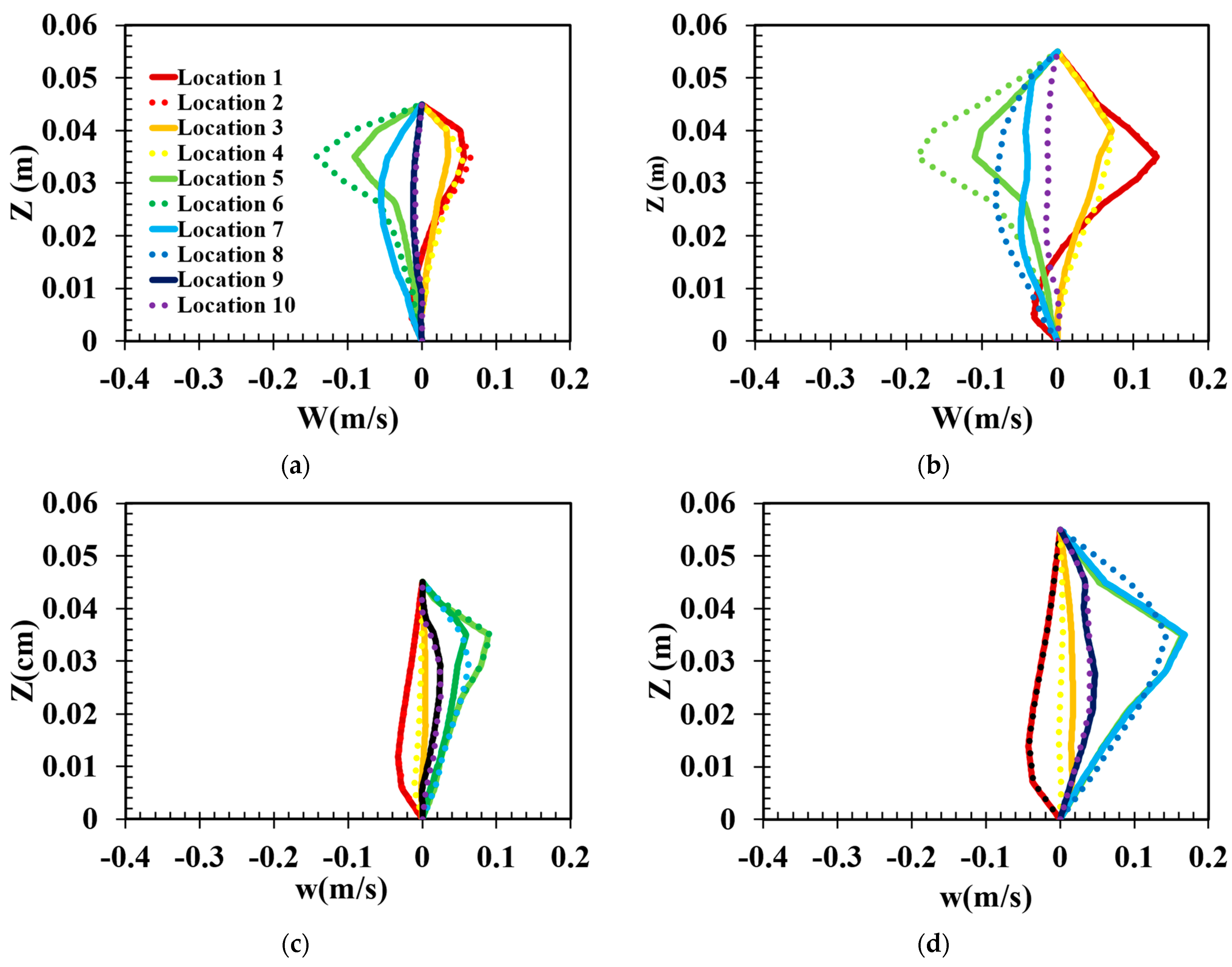
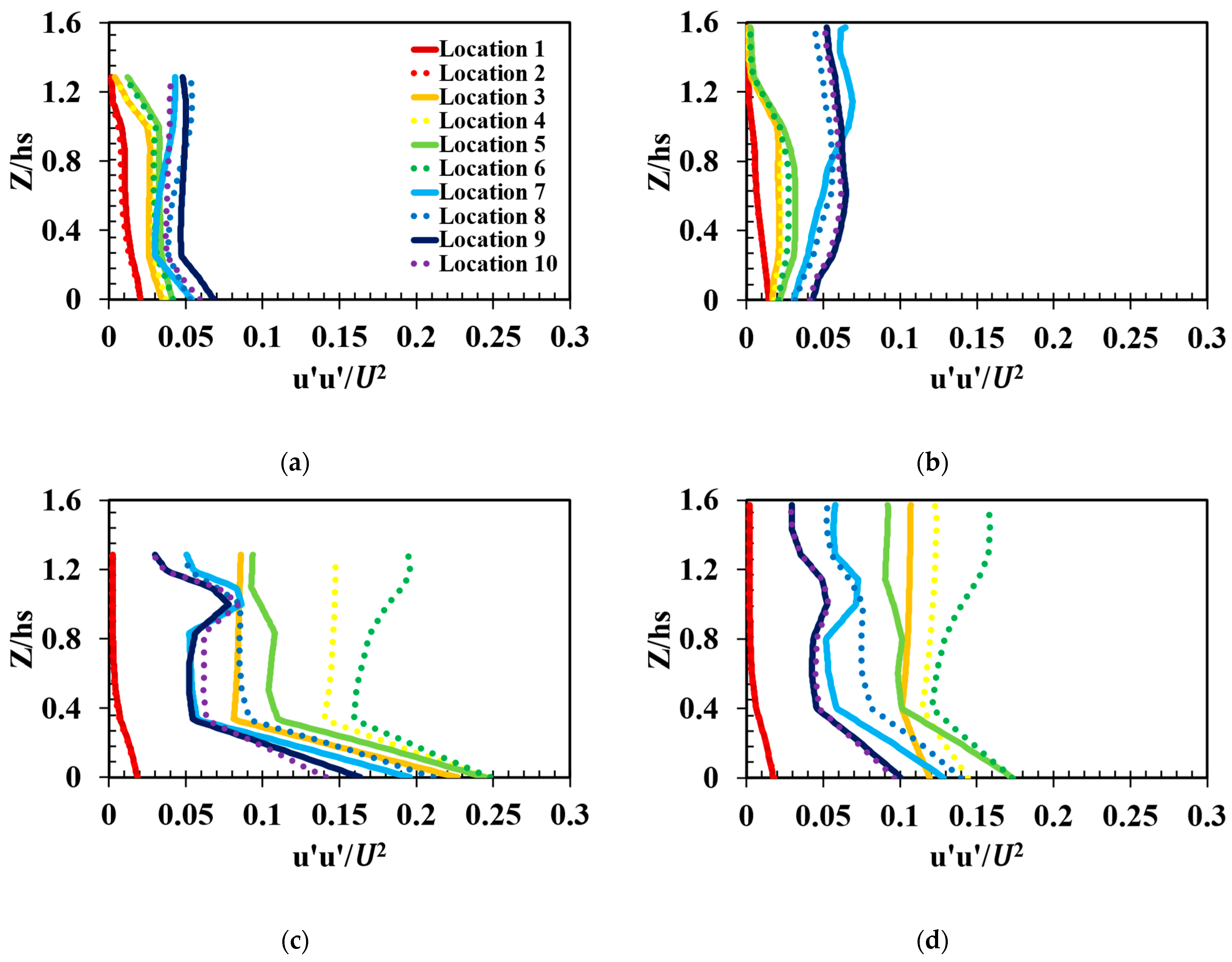
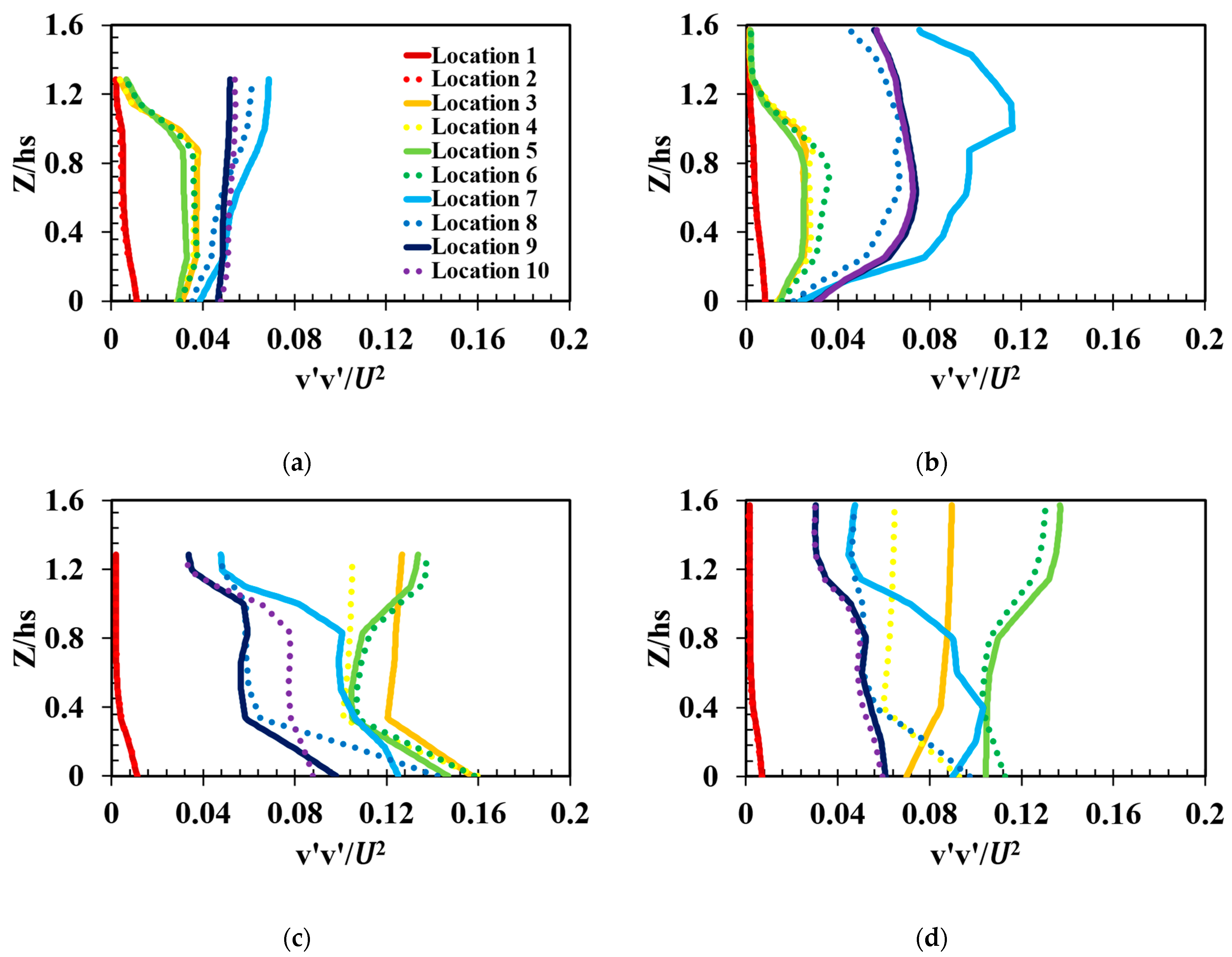


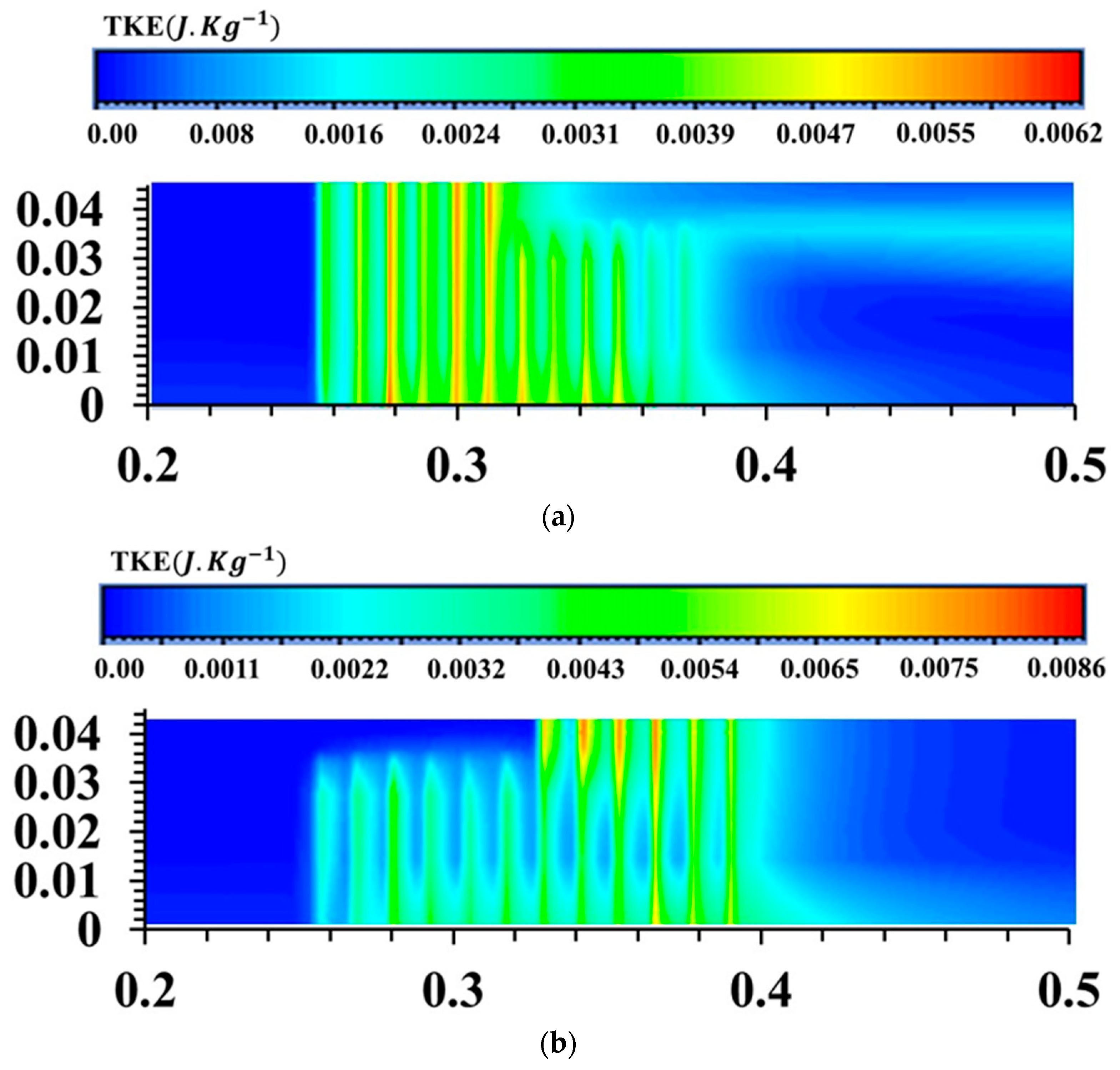
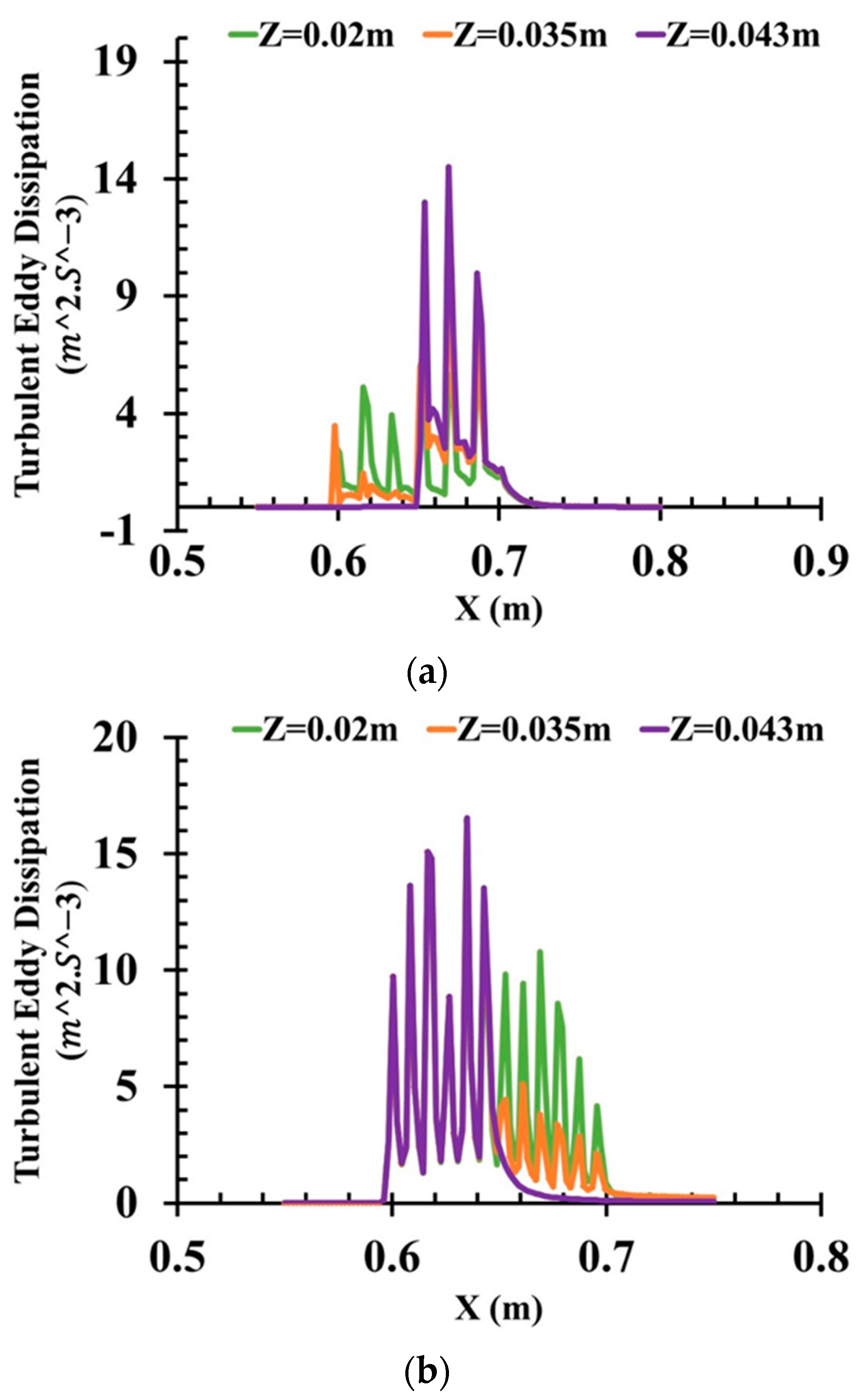
| Case No. | Vegetation Configuration | Z (cm) | Vegetation Density (Cylinders/m2) | Fr | Cylinder Arrangement |
|---|---|---|---|---|---|
| 1 | Short Patch + Tall Patch | 4.5 | 1.22 | 0.65 | Staggered |
| 2 | Short Patch + Tall Patch | 5.5 | 1.22 | 0.68 | Staggered |
| 3 | Tall Patch + Short Patch | 4.5 | 1.22 | 0.65 | Staggered |
| 4 | Tall Patch + Short Patch | 5.5 | 1.22 | 0.68 | Staggered |
Disclaimer/Publisher’s Note: The statements, opinions and data contained in all publications are solely those of the individual author(s) and contributor(s) and not of MDPI and/or the editor(s). MDPI and/or the editor(s) disclaim responsibility for any injury to people or property resulting from any ideas, methods, instructions or products referred to in the content. |
© 2023 by the authors. Licensee MDPI, Basel, Switzerland. This article is an open access article distributed under the terms and conditions of the Creative Commons Attribution (CC BY) license (https://creativecommons.org/licenses/by/4.0/).
Share and Cite
Abbas, F.M.; Tanaka, N.; Amina. Numerical Investigation of Internal Flow Properties around Horizontal Layered Trees by Using the Reynolds Stress Model. Mathematics 2023, 11, 712. https://doi.org/10.3390/math11030712
Abbas FM, Tanaka N, Amina. Numerical Investigation of Internal Flow Properties around Horizontal Layered Trees by Using the Reynolds Stress Model. Mathematics. 2023; 11(3):712. https://doi.org/10.3390/math11030712
Chicago/Turabian StyleAbbas, FAKHAR Muhammad, Norio Tanaka, and Amina. 2023. "Numerical Investigation of Internal Flow Properties around Horizontal Layered Trees by Using the Reynolds Stress Model" Mathematics 11, no. 3: 712. https://doi.org/10.3390/math11030712
APA StyleAbbas, F. M., Tanaka, N., & Amina. (2023). Numerical Investigation of Internal Flow Properties around Horizontal Layered Trees by Using the Reynolds Stress Model. Mathematics, 11(3), 712. https://doi.org/10.3390/math11030712





